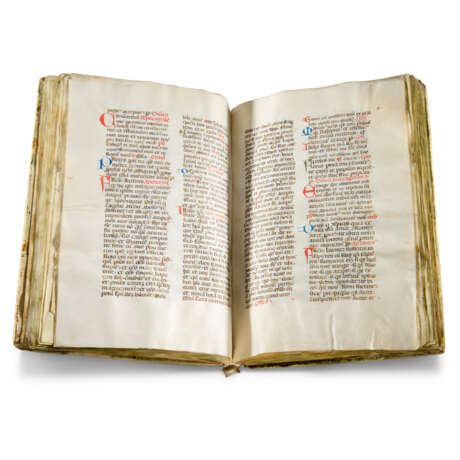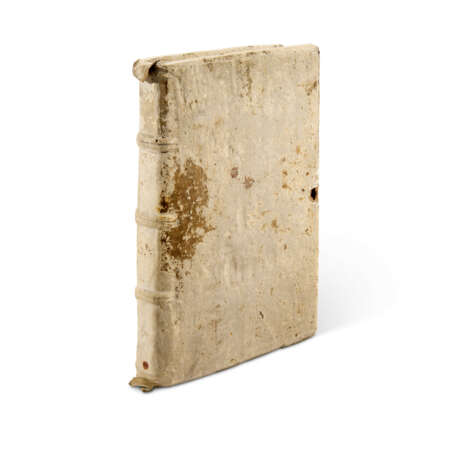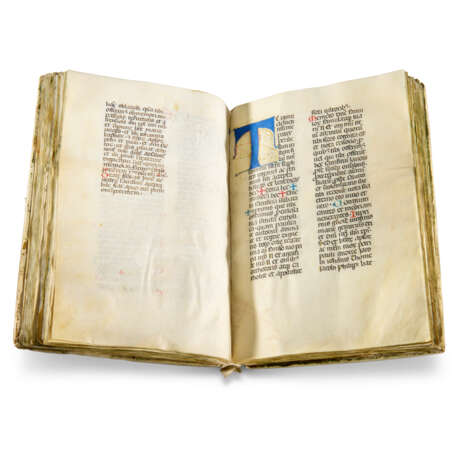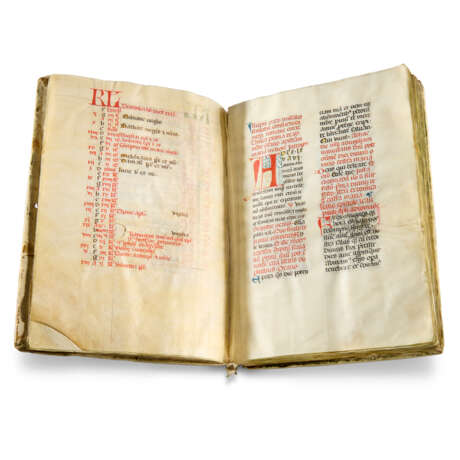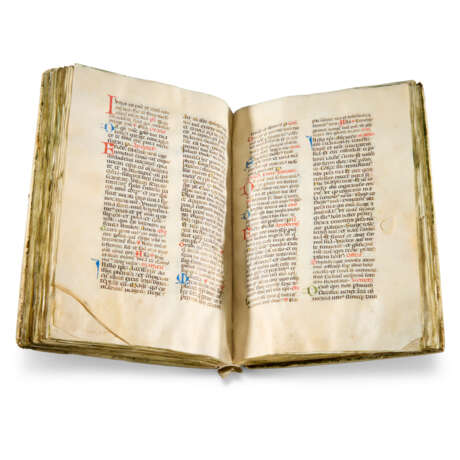ID 1214847
Lot 47 | A Tyrolese Missal
Estimate value
£ 30 000 – 50 000
Missal, use of Rome, in Latin, decorated manuscript on vellum [Eastern Dolomites, second half of the 15th century]
A Tyrolese Missal likely written for use in a parish church in the vicinity of Belluno; in an unrestored contemporary binding.
300 × 220mm. i + 107 leaves, collation: 14 (of 6, lacking i–ii; ff.1–4), 29 (of 10, lacking ix), 310, 47 (of 8, lacking ii), 56 (ff.31–36), 610, 7–98, 102 (ff.71–72), 11–1210, 132 (ff.91–92), 148, 157 (iv, f.104, is a singleton), catchwords and leaf signatures survive in many gatherings, two columns of 27 (gatherings 2, 3,and 6), ruled space: 185 × 140mm, or 37 lines, ruled space: 210 x 140mm, written in rounded gothic textura script, apparently by two scribes. one- and two-line initials alternately blue or red, three-line initials painted in red, blue, or green (an unusual colour) with foliate ornament in another colour, five-line initials to major feasts (Christmas, f.16, Epiphany, f.24, etc.), a six-line initial at the beginning of the main text (f.5), and an eight-line initial at the beginning of the Canon (f.37) (overall in very good condition; the parchment with a number of natural flaws, as expected of a book made in a provincial town).
Binding:
Contemporary binding sewn on three double bands laced into thick wood boards covered with green tawed skin (now faded except for some traces on the turn-ins), with tabs at head and tail of the spine, the edges of the leaves also green; vestiges of a (missing) strap-and-pin fastening at the fore-edge of the front board and in the middle of the back board (scuffed but sound).
Provenance:
(1) Perhaps written for use in a parish church in the vicinity of Belluno, at the southern edge of the Dolomites in northeastern Italy, about half-way between Venice and the present Austrian border: the most distinctive Saints in the calendar are Joathas (‘Johate martyris’, 22 May), and Lucanus (20 July), both of whose relics were at Belluno cathedral; several other Saints point to the same region: Godehard of Hildesheim (5 May), was venerated at Belluno; relics of St Florian, principal patron of Linz (4 May), were transferred to Vicenza, south-east of Belluno, in 1290; Hermagoras (12 July) was patron of Aquileia and venerated at Udine, east of Belluno. A possible clue to the dedication of the church is provided by the prayer immediately before the Canon, which names the Virgin Mary, John the Baptist, and Peter & Paul: normally John the Evangelist, not the Baptist, would be mentioned here.
(2) Unidentified German-speaking owner, with their 20th-century pencil inscription on the front flyleaf; sold at Sotheby’s, 18 June 1991, lot 127, bought by Quaritch for:
(3) The Schøyen Collection, MS 1372.
Content:
Calendar, ff.1–4v, lacking January–April, including many southern German, Austrian, and Swiss saints, e.g. Ulric (4 July), Hermagoras (12 July), Pantaleon (27 July), Affra (7 Aug.), Wolfgang (31 Oct.), and Conrad (26 Nov.); Temporale, from Advent to Palm Sunday, ff.5–34; Proper Prefaces, ff.34v–36v, followed by Gloria, Creed, and other (near-contemporary added) prayers; Canon of the Mass, ff.37–40; Temporale continued, ff.40–71, from Easter to the 24th Sunday after Pentecost; Blessings, ff.71v–72v, for salt and water, apples, bread, paschal lamb, milk and honey, cheese, etc.; Sanctorale, ff.73–92v, from St Andrew to St Catherine (i.e. from 30 Nov. to 25 Nov. the following year); Common of saints, ff.93–101; the Anniversary of the Dedication of a Church followed by masses for liturgical seasons and votive masses, ff.101v–107v, including a ‘Missa generalis sancti Augustini pro vivis et defunctis’, f.106, and ‘In agenda mortuorum’, f.106v.
The Missal is the book used by a priest when performing Mass. Every medieval priest, or every church and chapel, would have had at least one missal, and larger churches, with many altars, might have owned many. The calendar of the present volume has the simplest form of grading of the feasts, with the most important ones written in red. It is therefore likely that it was written for a parish church, rather than a larger institution with a more elaborate performance of the liturgy.
The volume would repay further research from the perspective of its physical attributes and production. First, the boards of the binding appear to have been reused from another binding, with channels from the former binding evident at the fore-edge of the inner face of the back cover. Second, not only is the textblock composed of a series of discrete codicological units, but it exhibits some changes of plan or lack of communication during the production process. One scribe wrote the first two gatherings of the main text, each of 10 leaves, and each with two columns of 27 lines, finishing at f.23v with the catchwords, ‘de innocentibus’. Another scribe subsequently crossed through this catchword, added these words below the bottom of the second column of text (outside the ruled space), and provided new catchwords: ‘In epiphania’. He then wrote the next two gatherings (of only 8 and 6 leaves each), on inferior parchment, with two columns of 37 lines in a larger rule space. The next codicological gathering, the Canon of the Mass, reverts to 10 leaves ruled for 27-lines, but the scribe, ruling, and vellum change again for the remaining gatherings.
| Place of origin: | Austria, Western Europe, Europe |
|---|---|
| Auction house category: | Medieval & renaissance manuscripts, Books and manuscripts |
| Place of origin: | Austria, Western Europe, Europe |
|---|---|
| Auction house category: | Medieval & renaissance manuscripts, Books and manuscripts |
| Address of auction |
CHRISTIE'S 8 King Street, St. James's SW1Y 6QT London United Kingdom | |
|---|---|---|
| Preview |
| |
| Phone | +44 (0)20 7839 9060 | |
| Buyer Premium | see on Website | |
| Conditions of purchase | Conditions of purchase |
